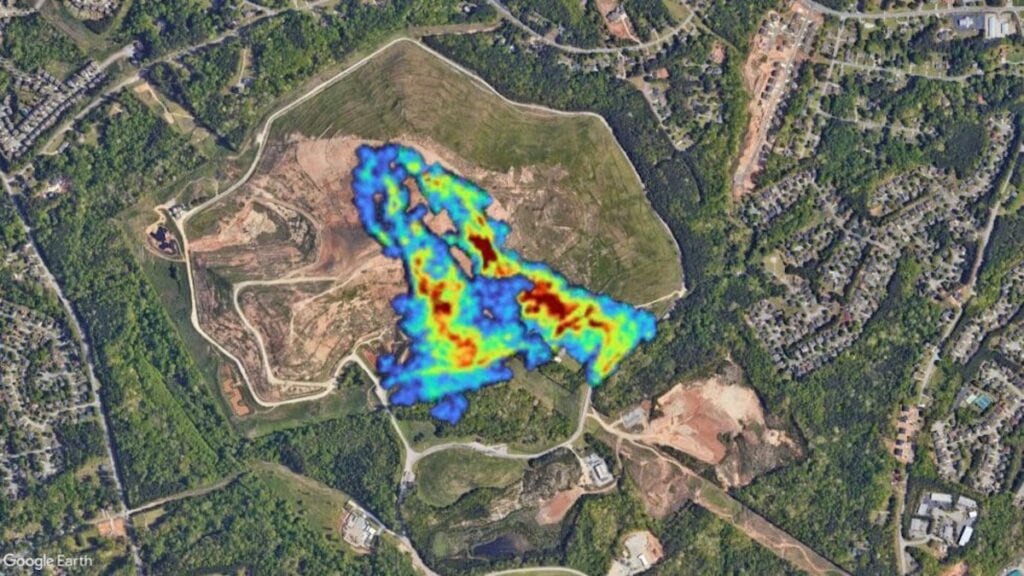More Than Half of U.S. Landfills Are Methane ‘Super-Emitters,’ Study Finds
4 min read
Large plumes of methane detected at a landfill in Georgia during U.S. airborne surveys. Carbon Mapper
Why you can trust us
Founded in 2005 as an Ohio-based environmental newspaper, EcoWatch is a digital platform dedicated to publishing quality, science-based content on environmental issues, causes, and solutions.
Methane is a heat-trapping greenhouse gas (GHG) that is 28 times more potent than carbon dioxide. Most methane comes from human activities — roughly 60 percent — such as agriculture, fossil fuels and the decomposition of waste in landfills.
According to a new study led by nonprofit Carbon Mapper, more than half the landfills in the United States are “super-emitters” of methane.
“Addressing these high methane sources and mitigating persistent landfill emissions offers a strong potential for climate benefit,” said Dr. Dan Cusworth, lead author of the study and a program scientist with Carbon Mapper, in a press release from Carbon Mapper. “The ability to precisely identify leaks is an efficient way to make quick progress on methane reduction at landfills, which could be critical for slowing global warming.”
The study, “Quantifying methane emissions from United States landfills,” published in the journal Science, is the largest measurement-based assessment of landfill methane ever conducted. It identifies major sources of emissions that have been absent from traditional accounting so that they can be given precedence for mitigation.
The research team — including scientists from NASA’s Jet Propulsion Laboratory, University of Arizona, Arizona State University, the U.S. Environmental Protection Agency (EPA) and airborne atmospheric research company Scientific Aviation — assessed hundreds of the country’s landfills using airborne surveys and direct observations.
The study not only emphasized the enormous impact of landfill emissions, but highlighted potential gaps in traditional methods of model-based accounting that could benefit from direct measurements using air-, surface- and space-based monitoring.
Landfills are the third largest human-caused methane emissions source in the country. The EPA reported that, in 2021, landfills made up 14.3 percent of methane, emitting GHG equal to almost 23.1 gas-powered passenger cars, according to the press release.
Despite their climate impacts, landfill methane emissions have been largely under-addressed in comparison with methane from other big emitters like oil and gas.
“Traditional surface-based surveys with handheld methane sensors provide an incomplete picture of emissions. This is due to factors like limited access to many sections of active landfills as well as logistical and personnel safety reasons,” the press release said.
From 2018 through 2022, the research team used advanced aircraft direct measurements of municipal solid waste landfills. They looked at more than 200 active landfills participating in the EPA’s Greenhouse Gas Reporting Program (GHGRP) — which makes up 20 percent of roughly 1,200 reported open landfills.
The team found methane plumes at more than half the landfills measured with airborne imaging spectrometers, reported CNN. This was much more than the detection rate of airborne studies of the oil and gas sector, the report said.
The researchers said the results indicated that GHGRP and other reporting systems were missing major sources of methane. They found that average landfill methane emission rates were 1.4 times those reported to GHGRP.
They also discovered that methane emissions from landfills were generally more constant than those of oil and gas — 60 percent lasted from months to years.
Another key finding of the study was that persistent emissions from landfills made up 87 percent of the study’s total quantified emissions. In comparison, most oil and gas methane super-emitters are short and irregular events.
The gaps in quantification protocols and leak detection at landfills in the U.S. were significant.
“Current walking surveys with hand-held sensors are ineffective in completely sampling the landfill surface and may miss high point source activity that can dominate the facility’s emissions while remaining undetected for extended periods,” the press release explained. “Advanced monitoring strategies, such as remote sensing from satellites, aircraft and drones, can provide a more accurate picture of landfill methane emissions. When combined with improved ground-based measurements, remote sensing can provide consistent, comprehensive measurements to better inform models, guide mitigation efforts and verify emission reductions.”
Rob Jackson, a Stanford University professor of environmental science who was not part of the study, called landfills “super-emitters,” CNN reported.
“Even in a future where there is not a reliance on fossil fuels, humans will likely still be generating waste. Even if we transition to cleaner fuels, we’re still going to be dealing with waste management,” Cusworth told CNN.
Due to its potent short-term heating effect, one of the best ways to mitigate climate change is to quickly reduce methane emissions, scientists have said.
“If we’re going to hit our climate targets, reductions in methane emissions can’t come from oil and gas alone. Landfills should be garnering a similar type of attention as oil and gas,” Cusworth said, as reported by CNN.
Subscribe to get exclusive updates in our daily newsletter!
By signing up, you agree to the Terms of Use and Privacy Policy & to receive electronic communications from EcoWatch Media Group, which may include marketing promotions, advertisements and sponsored content.





